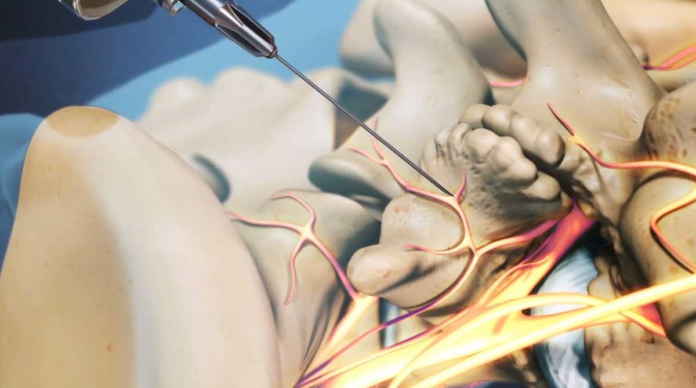If you’ve ever dealt with nagging back pain, you might’ve heard of something called a medial branch block. But what exactly is it? Let’s break it down, clear up some confusion, and separate fact from fiction.
What Is a Medial Branch Block?
A medial branch block is a type of injection doctors use to help diagnose and treat pain. Specifically, it targets the small nerves that carry pain signals from the facet joints in your spine. Think of these nerves as little messengers, sending alerts to your brain when your back’s not happy. By blocking these signals, doctors can figure out if the pain’s coming from the facet joints or somewhere else.
Common Myths About Medial Branch Blocks
Myth 1: Medial Branch Blocks Are Just for Old People
Many people think medial branch blocks are only for seniors with chronic pain. That’s not true! While older adults do often use this treatment, people of all ages can experience back pain. Whether you’re an athlete or just someone with a desk job, you could benefit from a medial branch block.
Myth 2: They’re Dangerous Procedures
Another common myth is that medial branch blocks are risky. Most people worry about needles and injections. However, these procedures are generally safe when performed by trained professionals. The needle used is very small, and the whole process is usually quick. Just like getting a flu shot, it can be done with minimal discomfort.
Myth 3: Medial Branch Blocks Are a Permanent Fix
Some folks think that getting a medial branch block means the pain will be gone forever. Unfortunately, that’s not accurate. While these blocks can provide quick relief, they generally don’t treat the underlying problem. It’s more like taking a pain pill; it can help, but it doesn’t solve the root issue.
The Benefits of Medial Branch Blocks
Fast Pain Relief
One of the main reasons people choose medial branch blocks is for fast pain relief. It can take effect almost immediately, making it a great option for those days when your back feels like it’s on fire.
Diagnostic Tool
Medial branch blocks can also help doctors pinpoint where the pain is coming from. By observing how a patient responds to the injection, doctors can determine if the facet joints are the cause of the pain.
Non-Surgical Option
For many, surgery is a last resort. Medial branch blocks can be an effective alternative to more invasive procedures. Who wouldn’t prefer a simple injection over undergoing surgery?
What to Expect During the Procedure
So, what happens when you go in for a medial branch block? First, you’ll meet with your doctor to discuss your symptoms. Then, you’ll lie down, and the doctor will clean the area on your back where the injection will go. You may get a little local anesthesia, which helps numb the spot. After that, the doctor will use a tiny needle to deliver a local anesthetic directly to the medial branches. The whole process is usually done in a matter of minutes.
Is It Right for You?
If you’re struggling with back pain, a medial branch block might be worth considering. It’s not the right solution for everyone, but talking to your doctor can help you decide. Just remember, it’s a tool to manage pain, not a magic button to make everything disappear.
Understanding Medial Branch Blocks: A Simple Guide
Medial branch blocks might sound complicated, but they can be quite straightforward when you break them down. This article will help you understand what medial branch blocks are, why they’re used, and how they can help those suffering from back pain.
What Are Medial Branch Blocks?
What does mbb mean in text? In simple terms, a medial branch block is an injection. It targets specific nerves that are responsible for sending pain signals from your back to your brain. Imagine these nerves as messengers carrying bad news—every ache and pain travels along these pathways. By blocking these nerves, doctors can stop the messages from getting through, providing much-needed relief.
Why Do People Get Medial Branch Blocks?
People with chronic back pain often seek medial branch blocks. This injection can help diagnose the source of pain and offer temporary relief. If the injection eases the pain, it indicates that the nerves being blocked are part of the problem. Think of it like turning off a noisy alarm. If you can silence it, you can find out if it was the root of the disturbance.
The Procedure: What to Expect
So, what happens during a medial branch block? First, a doctor will clean the area around your spine and may give you some local anesthesia to minimize discomfort. Then, they’ll use a thin needle to inject a numbing medication into specific areas near the nerves. Most people find this procedure quick, like a quick shot at the doctor’s office.
After the injection, doctors usually observe patients for a short time to monitor how they respond. This ensures everything is going smoothly and the pain relief can be assessed.
Benefits of Medial Branch Blocks
One major benefit of medial branch blocks is pain relief. Many patients experience significant relief, which can improve their daily life. Imagine being able to enjoy physical activities without the constant reminder of pain. It can be freeing!
Additionally, these blocks can help doctors determine the exact source of your pain. This information can guide better treatment plans moving forward, so it’s not just about relief; it’s about understanding and addressing the issue effectively.
Risks and Considerations
While medial branch blocks are generally safe, they aren’t without risks. Some people may experience soreness at the injection site or have an allergic reaction to the numbing medication. However, serious complications are rare. A good doctor will discuss these risks with you to ensure you’re well-informed before moving forward.
Conclusion: A Path to Pain Relief
Medial branch blocks can be an essential tool for managing back pain. They offer both relief and insight into the pain source, enabling better treatment options. If you’re struggling with chronic back pain, understanding medial branch blocks might be your first step towards feeling like yourself again.
Article Credit:
The Reyes Firm
1 813 421 3411
4730 N Habana Ave #201, Tampa, FL 33614, United States
Directions:

